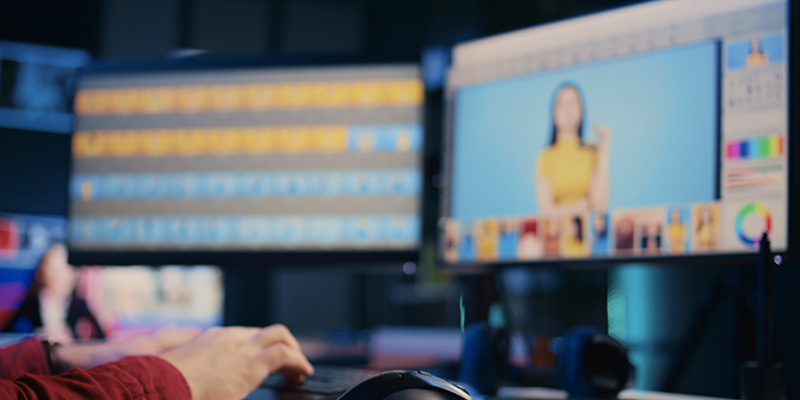Motion Graphics for Educational Content: Making Learning Engaging
In the digital age, the chalkboard has extended beyond the classroom into the realm of pixels and play buttons. Motion graphics have emerged as a powerful tool to transform traditional learning materials into captivating, engaging educational experiences. This blog dives into how e-learning video production, particularly motion graphics video, is revolutionizing the way we learn, making complex concepts more accessible and engaging for learners worldwide.
Reading Time: 5 Minutes
1. The Rise of E-Learning Video Production

E-learning has evolved rapidly, propelled by technological advancements and the growing need for accessible education. Video production, especially, has seen a surge in demand as educators and institutions seek to offer dynamic, visually engaging content. Motion graphics stand at the forefront of this revolution, offering a blend of entertainment and education that can make even the most complex subjects digestible.
2. Understanding Motion Graphics Video

Motion graphics is the art of bringing graphic design to life through animation. Unlike traditional animation, which often tells a story through characters and environments, motion graphics focus on the movement of graphic elements, text, and abstract shapes to convey information. This distinction makes motion graphics particularly suited for educational content, where the goal is to present information in a clear, engaging manner.
3. Advantages of Motion Graphics in Educational Content

3.1. Visual Learning Enhancement
Humans are visual creatures. Approximately 65% of the population comprises visual learners who absorb and recall information best when it’s presented visually. Motion graphics leverage this by transforming static information into dynamic visual stories, making learning not just more engaging but also more effective.
3.2. Simplifying Complex Concepts
Imagine trying to explain the intricacies of cellular biology or the complexities of astrophysics through text alone. Motion graphics can illustrate these concepts, breaking them down into understandable segments, much like how a chef deconstructs a complex dish into its basic ingredients for the audience to appreciate the individual flavors.
3.3. Increasing Engagement and Retention
Engagement is the currency of the digital learning age. Motion graphics captivate learners’ attention far more effectively than traditional textbooks. Studies suggest that learners retain 95% of a message when they watch it in video compared to 10% when reading it in text. Motion graphics make the learning process more memorable, ensuring that information doesn’t just enter one ear and exit the other.
4. Designing Effective Motion Graphics for E-Learning

4.1. Storyboarding for Educational Content
Storyboarding is akin to mapping out a journey before embarking on it. It involves plotting the narrative flow of the educational content, ensuring that each graphical element serves a purpose, whether it’s to highlight a key concept or to transition smoothly between topics.
4.2. Visual Aesthetics and Cognitive Load
The beauty of motion graphics lies in their ability to convey information in aesthetically pleasing ways without overwhelming the learner. By carefully selecting colors, fonts, and animation styles, educators can enhance learning without adding unnecessary cognitive load.
4.3. Incorporating Interactivity
Interactive motion graphics transform passive viewers into active participants. Imagine a motion graphic on the water cycle that allows learners to click on different stages (evaporation, condensation, precipitation) to explore each in more detail. This level of interactivity deepens the learning experience, making it more personalized and impactful.
5. Production Process: From Concept to Classroom

5.1. Pre-Production Planning
Effective e-learning content begins with meticulous planning. Defining the educational objectives and understanding the target audience are crucial first steps. Selecting the right tools and software for motion graphics creation sets the stage for a successful production.
5.2. Production Techniques
Animating educational concepts effectively requires a blend of creativity and pedagogical understanding. Incorporating voice-overs, sound effects, and music can further enhance the educational value of motion graphics, making the content not just visually appealing but also auditorily engaging.
5.3. Post-Production and Distribution
Quality checks and feedback loops are essential to refine educational content. Once finalized, the choice of platform for distributing e-learning video content can significantly impact its reach and effectiveness.
6. Case Studies: Success Stories in Motion Graphics Education

Innovative projects like Khan Academy and TED-Ed have demonstrated the power of motion graphics in education. These platforms have successfully used motion graphics to break down complex subjects into engaging, manageable chunks, making high-quality education accessible to millions worldwide.
7. Frequently Asked Questions

7.1. What are the best tools for e-learning video production?
Adobe After Effects, Blender, and Vyond are popular choices for creating motion graphics.
7.2. How do motion graphics improve learning compared to traditional methods?
They enhance engagement, improve retention, and make complex concepts simpler and more accessible.
7.3. Can motion graphics be used for any subject matter in education?
Yes, from humanities to STEM, motion graphics have versatile applications across all educational content.
7.4. What are the key challenges in producing educational motion graphics?
Balancing educational depth with engagement and managing production time and costs are significant challenges.
7.5. How can educators get started with using motion graphics in their teaching?
Start with simple tools and templates available online to integrate basic motion graphics into your lessons.
Conclusion
The journey from traditional education methods to the dynamic world of e-learning video production and motion graphics is a testament to the transformative power of technology in education. As we look to the future, the role of motion graphics in making learning not just more engaging but also more effective is undeniable. For educators and content creators alike, embracing this medium offers an exciting opportunity to redefine the educational landscape, making learning an engaging, enjoyable, and enriching experience for all.
Stay Updated with Video Production Trends!
Don’t miss the latest in video production. Subscribe now!